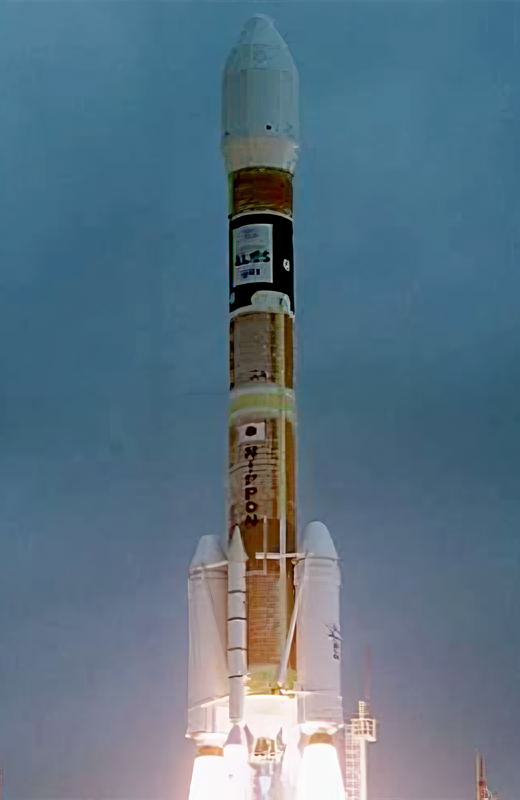
H-IIA
In-activeMitsubishi Heavy Industries (MHI)
Feb. 26, 2005
Description
The H-IIA rocket family is an expendable launch system operated by Mitsubishi Heavy Industries for the Japan Aerospace Exploration Agency. The liquid fuelled rocket has been used to launch satellites, lunar spacecraft and planetary science craft.
Specifications
-
Stages
2 -
Length
53.0 m -
Diameter
4.0 m -
Fairing Diameter
4.0 m -
Launch Mass
316.0 T -
Thrust
―
Family
-
Name
H-IIA -
Family
― -
Variant
2022 -
Alias
― -
Full Name
H-IIA 2022
Payload Capacity
-
Launch Cost
― -
Low Earth Orbit
― -
Geostationary Transfer
Orbit
4500.0 kg -
Direct Geostationary
― -
Sun-Synchronous Capacity
―
Mitsubishi Heavy Industries
Commercial
President: Seiji Izumisawa
MHI 1884Mitsubishi Heavy Industries, Ltd. is a Japanese multinational engineering, electrical equipment and electronics company headquartered in Tokyo, Japan. MHI is one of the core companies of the Mitsubishi Group. MHI's products include aerospace components, air conditioners, aircraft, automotive components, forklift trucks, hydraulic equipment, machine tools, missiles, power generation equipment, printing machines, ships and space launch vehicles. Through its defense-related activities, it is the world's 23rd-largest defense contractor measured by 2011 defense revenues and the largest based in Japan.
H-IIA 2022 | Kaguya
Mitsubishi Heavy Industries | JapanTanegashima Space Center, Japan
Sept. 14, 2007, 1:31 a.m.
Status: Launch Successful
Mission:
Kaguya, also known as SELENE, was the second Japanese lunar orbiter spacecraft. Kaguya usede a suite of 15 instruments to gather scientific data on lunar origins and evolution. The main orbiter was accompanied by two smaller satellites: a relay satellite Okina and a satellite Ouna for Very Long Baseline Interferometry observations. Kaguya orbited the Moon for a year and eight months and then ended the mission via a planned impact on the lunar surface.
Lunar OrbitH-IIA 2022 | Daichi
Mitsubishi Heavy Industries | JapanTanegashima Space Center, Japan
Jan. 24, 2006, 1:33 a.m.
Status: Launch Successful
Mission:
ALOS (Advanced Land Observation Satellite) is used for cartography, regional observation, disaster monitoring, and resource surveying. ALOS has three remote-sensing instruments: - the Panchromatic Remote-sensing Instrument for Stereo Mapping (PRISM) for digital elevation mapping with 2.5 meter resolution, - the Advanced Visible and Near Infrared Radiometer type 2 (AVNIR-2) for precise land coverage observation with 10 meter resolution, and - the Phased Array type L-band Synthetic Aperture Radar (PALSAR) for day-and-night and all-weather land observation. ALOS transmitts its data via the DRTS (Kodama) satellite. The ALOS was launched by an H-2A-2022 launch vehicle from the Tanegashima Space Center. ALOS as been given the nickname Daichi. Five minutes after spacecraft separation, ALOS began to unfurl its 72-foot solar array that will provide electrical power to the craft throughout its mission. Six cameras are on-board to visually verify the correct deployment of the solar panel and various instrument antennas. ALOS lost all power on 22. April 2011, thus ending the mission.
Sun-Synchronous OrbitH-IIA 2022 | Himawari-6 (MTSAT-1R)
Mitsubishi Heavy Industries | JapanTanegashima Space Center, Japan
Feb. 26, 2005, 9:25 a.m.
Long March 12
SatNet LEO Group 19
Commercial LC-2 - Wenchang Space Launch Site, People's Republic of ChinaA batch of 9 Low Earth Orbit communication satellites for the Chinese state owned SatNet constellation operated by the China Satellite Network Group.…
Falcon 9
Starlink Group 6-100
Space Launch Complex 40 - Cape Canaveral SFS, FL, USAA batch of 29 satellites for the Starlink mega-constellation - SpaceX's project for space-based Internet communication system.
Falcon 9
NROL-105
Space Launch Complex 4E - Vandenberg SFB, CA, USATwelfth batch of satellites for a reconnaissance satellite constellation built by SpaceX and Northrop Grumman for the National Reconnaissance Office …
Ceres-2
Demo Flight
Launch Area 95A - Jiuquan Satellite Launch Center, People's Republic of ChinaFirst test launch of Galactic Energy’s Ceres-2 rocket.
Long March 3B/E
Shijian 32
Launch Complex 2 (LC-2) - Xichang Satellite Launch Center, People's Republic of ChinaChinese experimental spacecraft of unknown purposes.

